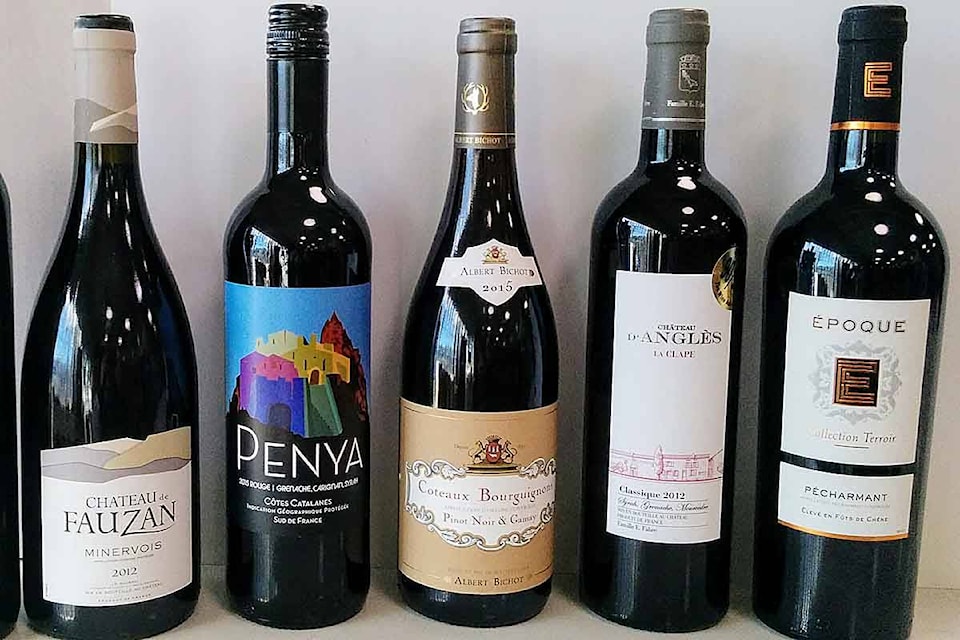Even with this year’s focus on the wines of Iberia at the Vancouver International Wine Festival, there are still 15 wineries or distributors attending and pouring samples of their fine French wines.
Steeped in centuries of tradition, regulated strictly though their Appellation d’Origine Contrôlée (AOC) system of certification, that guaranteed wines – as well as cheeses and other agricultural products – were true reflections of the regions where the grapes were grown. Not content to routinely confuse wine lovers elsewhere, that system in now reformatted as Appellation d’Origine Protégée (AOP).
Introduced in 2010 ‘Vin de France’ is the broadest designation for wines under the AOP system, replacing the ‘Vin de Table’ designation that had been in use since 1970. The ‘Vin de France’ designation permits producers to label their wines with vintage dates and grape varieties, both of which were disallowed for ‘Vin de Table’ wines.
In its oversized 1 Litre screw capped bottle, Grand Sud Merlot 2016 (789487) $13.99 is an excellent example of ‘Vin de France’. With headquarters in Petersbach, north of Strasbourg and close to the border with Germany, Grand Sud sources their wines from sunny Languedoc and Gascony vineyards along the Mediterranean coast. Juicy red and black berry and dusky plum flavours fill this quaffable red.
Minervois AOC/AOP is one of the largest wine-producing areas in Languedoc Roussillon, stretching along the rolling hills above the Mediterranean between Carcassonne and Narbonne. Here, red wines are produced from Carignan - no more than 40% of the blend – Grenache and its cousin Lledoner Pelut, Mourvedre and Syrah.
Château de Fauzan stands on higher ground to the extreme east of the Minervois region and La Livinière, bordering on Muscat de Saint Jean on a clay-limestone terroir. Chateau Fauzan Minervois (787937) $17.90 is a dusky red wine with aromas and flavours of dark fruit, liquorice and black cherry.
Once known as Vin de Pays – a cut above Vin de Table or Vin de France – Cotes Catalanes IGP (Indication Géographique Protégée) covers non-AOC/AOP wines from the area west of Minervois to the Spanish border.
Penya Rouge Cotes Catalanes IGP (199709) $22.99 is a sturdy blend of 52 per cent Grenache, 36 per cent Carignan and 12per cent Syrah. Relatively full-bodied, it flaunts aromas and flavours of ripe plums and cherries with smoky, peppery notes. Ripe tannins add weight to the finish and a meaty hint of bacon begs for pairing with barbequed foods.
AOC/AOP Coteaux Bourguignons was declared in 2011 – the ‘slopes of Burgundy’. Up until then the wines were known as Bourgogne Grand Ordinaire. Reds are typically blends of at least 90 per cent Pinot Noir and Gamay, with up to 10 per cent of a variety of other wine grapes.
Surprisingly full-bodied for a blend of red wine’s lightest grapes, Albert Bichot Coteaux Bourguignons (174546) $22.99 shows a medley of fruity, earthy beet aromas and flavours of dried strawberries, blackcurrants and beets. A subtle twist of woody liquorice fills out the finish.
Located in the Aude department, AOC La Clape extends from Narbonne to the Mediterranean over an area of 17 kilometers in length and width. Like the wines of the Rhone Valley, the primary red wine grapes of La Clape are Grenache, Mourvèdre and Syrah.
A dark and dusky blend of 40 per cent Grenache, 40 per cent Syrah and 20 per cent Mourvèdre, Chateau D’Angles La Clape Classique 2012 (174953) $25.99 is a sturdy mouthful of sweet red and black fruits, new leather, peppery sage and liquorice. An excellent example of this Appellation Communale, the 2012 vintage preceded the official AOC/AOP recognition in 2015 by three years.
South-east of Bordeaux, north-east of the town of Bergerac, the Pécharmant appellation has a specific sub-soil made of ferruginous concretions – iron-rich clay. This terroir is reputed to produce pungent, generous and unique wines.
Hand-harvesting and sorting, destemming, long vatting, manual cap-punching and pneumatic pressing - along with some aging in oak barrels produces full bodied reds like Epoque Collection Terroir Pécharmant 2015 (115301) $31.49. A masterful blend of Merlot, Cabernet-Sauvignon, Cabernet Franc, and Malbec, this luscious, spicy red will only get better with 5 -10 years of cellaring.
Overlooked and undervalued, wines from some of these less well-known French regions are well worth the trouble it might take to find them.
See more French red wine (other than Bordeaux) options from Mirror wine columnist Doug Sloan at campbellrivermirror.com
Reach WineWise by emailing douglas_sloan@yahoo.com
